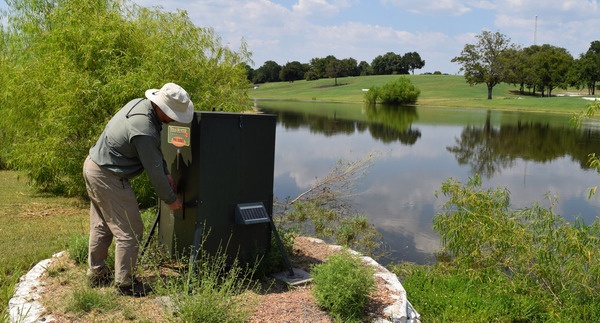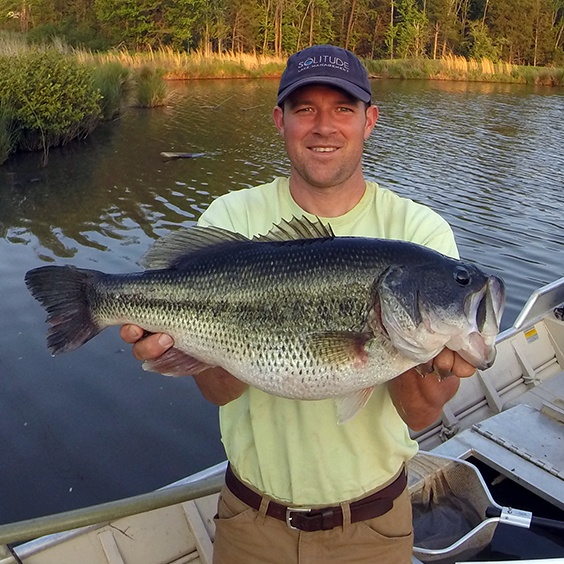
Written by Industry Expert Dave Beasley, Fisheries Biologist and Director of Fisheries
As you may know, phosphorus is a nutrient that helps fuel the growth of aquatic plants and algae. The amount of phosphorus that waterbody owners and managers want or tolerate will vary significantly depending on goals. For example, a community manager seeking clear water with minimal aquatic growth in their stormwater pond will have a much lower tolerance for phosphorus than a private landowner whose goal is to produce trophy bass or attract waterfowl. Depending on these goals, along with your budget and the characteristics of your waterbody, the maximum amount of phosphorus that is considered desirable or acceptable will vary.
From a fisheries perspective, phosphorus is important, since it plays a leading role in how productive a waterbody can become (productivity refers to the movement of energy up the food chain, starting with microscopic algae species and ending with predator fish). And although phosphorus is critical to the productivity and success of a fishery, it can also be detrimental if levels become excessive. Too much phosphorus can contribute to overabundant aquatic plant and algae production, which typically leads to poor water quality, loss of habitat and unhealthy fish.
Another negative and more serious impact of excessive phosphorus is the increased odds of promoting cyanobacteria blooms. Cyanobacteria, commonly called blue-green algae, thrive in phosphorus-rich environments. Not only are blue-green algae blooms unsightly, but they can also pose a serious threat to the health of humans, pets and wildlife. Additionally, new research suggests that exposure to potentially toxic blue-green algae blooms may be connected to the development of neurological diseases like Alzheimer’s, Parkinson’s and ALS.
 Properly managing phosphorus levels and maintaining an optimal level of productivity is an ongoing process that requires water quality monitoring and making routine visual observations. Preventative management strategies may include the installation of a bottom diffused aeration system, maintenance of beneficial in-water vegetation and use of low-phosphorus fish feed. Fisheries management technology is continually improving, and low-phosphorus fish feed is a great example of a new and potentially game-changing product. This new type of feed produces less phosphorus waste than traditional feeds, without compromising fish growth or fish health. With technology of this nature, fisheries biologists are able to more easily reach fish growth goals, while contributing less phosphorus to the waterbody.
Properly managing phosphorus levels and maintaining an optimal level of productivity is an ongoing process that requires water quality monitoring and making routine visual observations. Preventative management strategies may include the installation of a bottom diffused aeration system, maintenance of beneficial in-water vegetation and use of low-phosphorus fish feed. Fisheries management technology is continually improving, and low-phosphorus fish feed is a great example of a new and potentially game-changing product. This new type of feed produces less phosphorus waste than traditional feeds, without compromising fish growth or fish health. With technology of this nature, fisheries biologists are able to more easily reach fish growth goals, while contributing less phosphorus to the waterbody.
One of the primary reasons why phosphorus is challenging to manage is because it naturally accumulates over the years, resulting in elevated levels. When phosphorus levels exceed a desirable threshold, it can become necessary to implement control measures in order to bring levels back into a desirable range. Nutrient mitigation products like Phoslock can be utilized to bind with phosphorus, effectively removing free reactive phosphorus (FRP) from the water column. At times, it may make sense to treat the symptoms of the phosphorus levels using herbicides and algaecides. Knowing when to mitigate phosphorus and when to only treat the symptoms will depend on management objectives, water quality data and the time of year.
Understanding and managing phosphorus levels is an important, yet oftentimes overlooked aspect of a Fisheries Management Plan. A fisheries biologist can help you understand what your current phosphorus levels are, and then determine where they should be relative to your goals, budget, waterbody and watershed. At that point the appropriate management strategy can be executed, helping create a productive and sustainable fishery that will exceed all expectations.
Contact the experts at 888-480-5253 for all of your lake, pond, wetland and fisheries management needs.
 David Beasley is a Fisheries Biologist leading the fisheries division for all of SOLitude’s service areas. David has an extensive background in progressive management techniques related to water quality, plankton management, fish species management and population dynamics, and is highly experienced in the creation and maintenance of both balanced and trophy fisheries. His expertise includes the management of ponds and indoor facilities for aquaculture purposes, and the development of more than 27 species of forage and predator fish.
David Beasley is a Fisheries Biologist leading the fisheries division for all of SOLitude’s service areas. David has an extensive background in progressive management techniques related to water quality, plankton management, fish species management and population dynamics, and is highly experienced in the creation and maintenance of both balanced and trophy fisheries. His expertise includes the management of ponds and indoor facilities for aquaculture purposes, and the development of more than 27 species of forage and predator fish.
SOLitude Lake Management is a nationwide environmental firm committed to providing sustainable solutions that improve water quality, enhance beauty, preserve natural resources and reduce our environmental footprint. SOLitude’s team of aquatic resource management professionals specializes in the development and execution of customized lake, pond, wetland and fisheries management programs that include water quality testing and restoration, nutrient remediation, algae and aquatic weed control, installation and maintenance of fountains and aeration systems, bathymetry, mechanical harvesting and hydro-raking, lake vegetation studies, biological assessments, habitat evaluations, and invasive species management. Services and educational resources are available to clients nationwide, including homeowners associations, multi-family and apartment communities, golf courses, commercial developments, ranches, private landowners, reservoirs, recreational and public lakes, municipalities, drinking water authorities, parks, and state and federal agencies. SOLitude Lake Management is a proud member of the Rentokil Steritech family of companies in North America.










